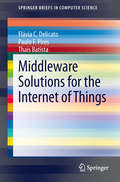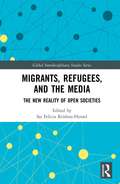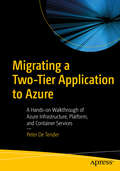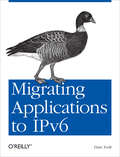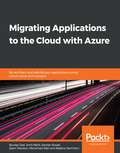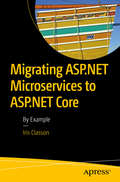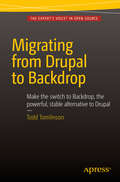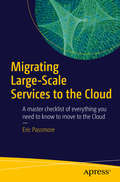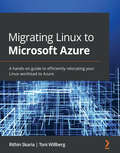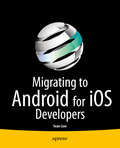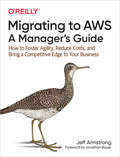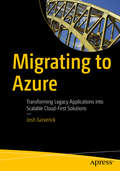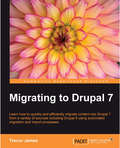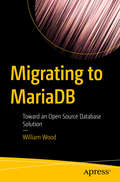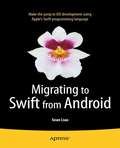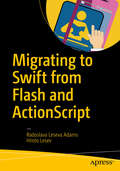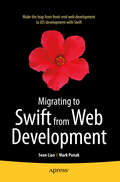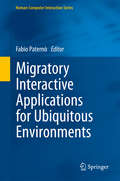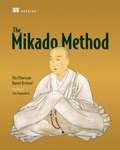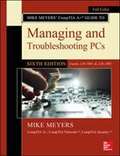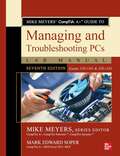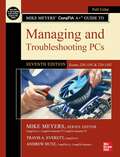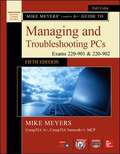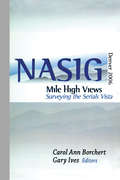- Table View
- List View
Middleware Solutions for the Internet of Things
by Flávia C. Delicato Paulo F. Pires Thais BatistaAfter a brief introduction and contextualization on the Internet of Things (IoT) and Web of Things (WoT) paradigms, this timely new book describes one of the first research initiatives aimed at tackling the several challenges involved in building a middleware-layer infrastructure capable of realizing the WoT vision: the SmartSensor infrastructure. It is based on current standardization efforts and designed to manage a specific type of physical devices, those organized to shape a Wireless Sensor Network (WSN), where sensors work collaboratively, extracting data and transmitting it to external networks to be further analysed and processed. Middleware Solutions for the Internet of Things describes this infrastructure and its RESTful-based programming model that allows developers create applications without having specific knowledge about physical devices or networking environments. It is also shown, step by step, how to create a Web Mashup application using SmartSensor.
Migrants, Refugees, and the Media: The New Reality of Open Societies (Global Interdisciplinary Studies Series)
by Sai Felicia Krishna-HenselThe large-scale movements of refugees and economic migrants from conflict zones to more stable societies have resulted in challenges, both for new entrants and their hosts. This fascinating volume brings together a collection of media analyses focused on immigration issues to examine how migration has been represented to the public. Case studies exploring media coverage of migrants and refugees in Europe enable the reader to better understand the complexity of the process through a range of unique and unexplored dimensions of immigration analysis, including strategic framing theory, game structure analysis, migration maps and routes, television narratives, rumour-based communication, and state-bred campaigns. The insights into the perspective of migrants, the general public and policy makers provide innovative methodological and theoretical analysis on population movements which will be of interest to scholars, students, and policy makers working in the fields of migration studies, international relations, peace and security studies, and social and public policy.
Migrating a Two-Tier Application to Azure: A Hands-on Walkthrough of Azure Infrastructure, Platform, and Container Services
by Peter De TenderUnderstand and build a proof of concept by migrating a multi-tiered .NET Core web application to the Azure public cloud, leveraging different Azure Infrastructure as a Service (IAAS), Azure Platform as a Service (PaaS), and Azure Container offerings. These include Azure Container Instance (ACI), Azure Kubernetes Services (AKS), and CI/CD pipeline deployments using Azure DevOps. After a first chapter in which you set up the baseline for the lab scenarios, you will start with the basics of automating Azure resource deployments using Visual Studio and powerful Azure Resource Manager (ARM) templates. Next, you’ll learn about the importance of performing proper assessments and the tools Microsoft offers to help in this migration preparation phase. After that, you will validate the virtual machine deployment and learn about SQL Server database migration to SQL Azure PaaS, as well as deploying and migrating web applications to Azure Web Apps. After covering these foundational platform components, the next chapters focus on the core concepts and advantages of using containers for running business workloads. These labs are based on Docker, Azure Container Registry (ACR), ACI, and Web App for Containers, and show you how to enable container orchestration and cloud-scale using AKS. In the last part of the book, you will work with Azure DevOps, the Microsoft application lifecycle environment, building a CI/CD pipeline to publish workloads using the DevOps principles and concepts. You’ll see the integration with the rest of the Azure services, closing with a module on overall Azure monitoring and operations and what tools Azure has available to assist your IT teams in this challenge.What You Will Learn Use Azure to enable digital transformation Carry out Azure automated deployments using ARM templates and Azure DevOps Run VM-based workloads on Azure Migrate VM-based workloads to Azure platform services Monitor Azure running workloads with Azure Monitor and Log Analytics Who This Book Is For Anyone who wants to learn about different Azure architectures by going through hands-on exercises.
Migrating Applications to IPv6: Make Sure IPv6 Doesn't Break Your Applications
by Dan YorkIf IPv6 is to be adopted on a large scale, the applications running on desktop systems, laptops, and even mobile devices need to work just as well with this protocol as they do with IPv4. This concise book takes you beyond the network layer and helps you explore the issues you need to address if you are to successfully migrate your apps to IPv6. It's ideal for application developers, system/network architects, product managers, and others involved in moving your network to IPv6. Explore changes you need to make in your application's user interface Make sure your application is retrieving correct information from DNS Evaluate your app's ability to store and process both IPv6 and IPv4 addresses Determine if your app exposes or consumes APIs where there are IP address format dependencies Work with the network layer to ensure the transport of messages to and from your app Incorporate IPv6 testing into your plans, and use the correct IPv6 addresses in your documentation
Migrating Applications to the Cloud with Azure: Re-architect and rebuild your applications using cloud-native technologies
by Sjoukje Zaal Amit Malik Sander Rossel Jason Marston Mohamed WaliModernize your apps with Microsoft Azure by moving web, desktop, and mobile apps to the cloud Key Features Decide which migration strategy is most suitable for your organization and create a migration roadmap Move existing infrastructure to Azure and learn strategies to reduce cost, increase storage, and improve ROI Design secure, scalable, and cost-effective solutions with the help of practical examples Book Description Whether you are trying to re-architect a legacy app or build a cloud-ready app from scratch, using the Azure ecosystem with .NET and Java technologies helps you to strategize and plan your app modernization process effectively. With this book, you'll learn how to modernize your applications by using Azure for containerization, DevOps, microservices, and serverless solutions to reduce development time and costs, while also making your applications robust, secure, and scalable. You will delve into improving application efficiency by using container services such as Azure Container Service, Azure Kubernetes Service (AKS), and more. Next, you will learn to modernize your application by implementing DevOps throughout your application development life cycle. You will then focus on increasing the scalability and performance of your overall application with microservices, before learning how to add extra functionality to your application with Azure serverless solutions. Finally, you'll get up to speed with monitoring and troubleshooting techniques. By the end of this book, you will have learned how to use the Azure ecosystem to refactor, re-architect, and rebuild your web, mobile, and desktop applications. What you will learn Use DevOps and containerization technologies to modernize your applications and infrastructure Build microservices using Azure Service Fabric Develop scalable applications using Azure Functions Manage and deploy your application code and database connectivity Secure and monitor your applications in Azure effectively Design for high availability and disaster recovery Who this book is for This book is for.NET and Java developers who want to modernize their applications using Azure. Solution architects and experienced developers interested in modernizing legacy applications using Azure will also find this book useful. Some prior understanding of cloud computing concepts will be beneficial.
Migrating ASP.NET Microservices to ASP.NET Core: By Example
by Iris ClassonMigrate your existing microservice cluster from ASP .NET to ASP .NET Core. While improved performance and cross-platform support are evident, this book helps you cut through the noise to determine how, when, and to what extent a migration is needed.Microsoft’s introduction of .NET Core has created a lot of excitement, but also a lot of confusion for developers accustomed to ASP applications and services. This book gives you specific steps to embark on a partial or full SaaS microservices system migration, factoring in limited resources, time, and finances. In addition to practical advice and real-world examples, many mishaps will be shared, providing you with a complete 360-degree view of a migration.As a developer intimately familiar with the migration process, author Iris Classon shares prescriptive guidance on every part of the system—from code, dependencies, editors, integration, and the deployment pipeline to a distribution model. You will come away with all the information you need to plan and prepare your migration to ASP.NET Core.What You’ll LearnConduct an in-depth, pre-migration analysis of your system Know the differences between ASP .NET and ASP .NET CorePlan for and execute a full or partial migration to ASP .NET Core Understand the continuous integration and deployment process Gain insight on tools and templates that will accelerate and facilitate the migration processLeverage a real-world migration example, complete with genuine challengesMigrate specific components such as logging, authentication, data access, and moreWho This Book Is ForDevelopers who are considering or are tasked with migrating an existing microservice cluster from ASP.NET to ASP.NET Core. Experience with C#, Web API, ASP.NET, Visual Studio, and PowerShell is helpful.
Migrating from Drupal to Backdrop
by Todd TomlinsonMigrate an existing Drupal 6 or 7 website to Backdrop and discover why you should consider using Backdrop when building a new website. You'll learn what Backdrop is, how to install and configure Backdrop, and create and manage content. Migrating from Drupal to Backdrop focuses on the user who is responsible for building, maintaining, and managing an organization's website and who is interested in Backdrop's ability to meet their site's requirements. There is a major shift in the open source CMS market and Backdrop is emerging as a significant force. The Drupal team's decision to rebuild Drupal 8 on Symfony has many developers and organizations in a quandary - do you learn a whole new framework and undertake the effort of migrating to Drupal 8, stay on Drupal 7 which will at some point be officially unsupported, or adopt Backdrop as their go-forward strategic platform? There is also a large mid-market that may not have the ability to scale up with the skills required to support Drupal 8 (Symfony), making Backdrop a viable and attractive alternative. By reading this book, you will: Understand why you should use Backdrop and the power of the platform Quickly build confidence in your ability to use Backdrop Gain the knowledge necessary to build, deploy, and manage web sites of moderate complexity on Backdrop Understand the process for migrating a Drupal 6 or 7 site to Backdrop What you'll learn What Backdrop is and why you should use it How to install a basic Backdrop web site from scratch How to create content in your new Backdrop web site How to install and configure modules How to migrate a Drupal 6 site to Backdrop How to migrate a Drupal 7 site to Backdrop Who this book is for This book is for technical users who need to use Backdrop to create websites using the platform or to manage existing content, as well as developers who are new to the Backdrop platform. The book is also targeted at organizations that currently use Drupal 6 or 7 and who wish to remain on the base architecture of those platforms as they move forward on Backdrop. Table of Contents 1. Introduction to Backdrop 2. Installing Backdrop 3. Editorial and Administration Interface Differences 4. Backdrop Modules and Themes 5. Converting Modules to Backdrop 6. Porting Drupal Themes 7. Creating Layouts 8. Migrating to Backdrop 9. Migrating to Backdrop from Drupal 6 A. Where to Learn More B. Additional Resources
Migrating Large-Scale Services to the Cloud
by Eric PassmoreThis book reveals the technical challenges and successful implementation details of migrating MSN, Microsoft's consumer content portal--a business with 450 million worldwide users--into the Cloud. Following a technique long used in aviation, medicine, and other fields, MSN's Chief Technical Officer, Eric Passmore, describes the set of release, deployment, monitoring, and mitigation checklists used to build cloud services supporting hundreds of millions of users on Azure, Microsoft's Public Cloud. An undertaking of this scale--involving services supported by a large team of engineers--involves unique challenges and risks. This book demonstrates through personal experience how to cut through the theory and provides checklists as a surprisingly simple antidote to the competing methodologies. This book works at two levels. At a fundamental level, businesses need to be successful in the cloud if they want to seize new opportunities and transform their business to compete successfully. This book provides a framework for success by identifying the "hidden" work as part of moving to the cloud. At a more practical, level there is an incredible hunger for simple to follow, "how-to" information on Cloud migration. This book is a reference guide to reduce risk and achieve success without requiring the busy reader to wade through theory. It contains simple to follow, "how-to" information on cloud migration. It is a reference guide to achieving success, and any team can modify these tasks to fit the needs of their own organization. What you'll learn Pre-Release checklist Deployment checklist Monitoring and Alerting checklist Incident Mitigation checklist Who this book is for Technology professionals who deploy services in the cloud or are thinking of moving to the cloud. Professionals in the DevOps and Cloud services fields need these skills to succeed in their current jobs or advance their careers.
Migrating Linux to Microsoft Azure: A hands-on guide to efficiently relocating your Linux workload to Azure
by Rithin Skaria Toni WillbergLearn to move on-premises virtual machines running on Linux servers to Azure with expert guidance, best practices, and optimized costKey FeaturesWork with real-life migrations to understand the do's and don'ts of the processDeploy a new Linux virtual machine and carry out automation and configuration managementLearn debugging your system and collecting error logs with hands-on examplesBook DescriptionWith cloud adoption at the core of digital transformation for organizations, there has been a lot of demand to deploy and host enterprise business workloads in the cloud. Migrating Linux to Microsoft Azure offers a series of actionable insights into deploying Linux workload to Azure.You will begin by learning about the history of IT, operating systems, Unix, Linux, and Windows, before moving on to look at the cloud and what things were like before virtualization. This will enable those not very familiar with Linux to learn the terms required to grasp the upcoming chapters. Furthermore, you will explore popular Linux distributions including RHEL 7, RHEL 8, SLES, Ubuntu pro, CentOS 7, and more.As you progress, you will dive into the technical details of Linux workloads such as LAMP, Java, and SAP. You will learn how to assess your current environment and plan migrating to Azure through cloud governance and operations planning.Finally, you will go through the execution of a real migration project and learn how to analyze, debug, and recover some common problems Linux on Azure users have encountered. By the end of this Linux book, you will be proficient in performing an effective migration of Linux workloads to Azure for your organization.What you will learnExplore the terminology and technology of various Linux distributionsUnderstand the technical support co-operation between Microsoft and commercial Linux vendorsAssess current workloads by using Azure MigratePlan cloud governance and operationsExecute a real-world migration projectManage project, staffing, and customer engagementWho this book is forThis book is intended to benefit cloud architects, cloud solution providers, and any stakeholders dealing with migration of Linux workload to Azure. Basic familiarity with Microsoft Azure would be a plus.
Migrating to Android for iOS Developers
by Sean LiaoMigrating to Android for iOS Developers gives you--as an experienced native iOS app developer--the skills to learn native Android apps development from scratch. Starting with preparing your Android integrated development environment and introducing just enough Android application framework fundamentals, you'll understand how to create a simple but meaningful HelloAndroid project immediately. This book provides the guidelines and tutorial projects to show you how to translate your existing iOS app to the Android platform. You'll use your mobile app knowledge to structure your Android apps in a similar way to how you would structure your iOS apps. To implement use cases with detailed screens, the most common mobile topics are discussed, including user interfaces, managing data, and networking with remote services. As you move through the book, you'll create Android apps with rich UI components to handle common CRUD operations locally and remotely. There are many Android goodies described in the book. Instead of relying on routine text descriptions, you'll discover the uniqueness of Android and appreciate the many features that are unique to the platform. This book also explores more powerful mobile UX patterns that are commonly used on the iOS and Android platforms. When you finish reading Migrating to Android for iOS Developers, you'll be an Android developer as well as an iOS developer. And, you will be fully convinced you can do everything in Android that you can do in iOS. What you'll learn * How to maximize your existing iOS mobile knowledge to learn Android programming skills * How to use the Android integrated development environment with the Eclipse ADT plugin * How to translate your existing iOS code to Android with the following common mobile topics: ° Common mobile screen navigation patterns ° User interface components and UI animations ° Storing data ° Networking and using remote services ° Using system apps ° Maps and location awareness ° Mobile search frameworks ° Mobile analytics Who this book is for This book is for iOS app developers--like you--who want to port their native iOS app to become an Android app. Also, if you are not an iOS developer, but already familiar with mobile apps, then this book can also help you understand Android development with step-by-step instructions and tutorial projects. Table of Contents 1. Setup Development Environment 2. Android Programming BasicsChapter 3. Structure your App and Break it into Components 4. Implement Piece by Piece 5. More About Android Application Components 6. Android Application Resources 7. Common Mobile Use Cases 8. Pulling it all together - Recap with a Case Study 9. Appendix
Migrating to AWS: How to Foster Agility, Reduce Costs, and Bring a Competitive Edge to Your Business
by Jeff ArmstrongBring agility, cost savings, and a competitive edge to your business by migrating your IT infrastructure to AWS. With this practical book, executive and senior leadership and engineering and IT managers will examine the advantages, disadvantages, and common pitfalls when moving your company’s operations to the cloud.Author Jeff Armstrong brings years of practical hands-on experience helping dozens of enterprises make this corporate change. You’ll explore real-world examples from many organizations that have made—or attempted to make—this wide-ranging transition. Once you read this guide, you’ll be better prepared to evaluate your migration objectively before, during, and after the process in order to ensure success.Learn the benefits and drawbacks of migrating to AWS, including the risks to your business and technologyBegin the process by discovering the applications and servers in your environmentExamine the value of AWS migration when building your business caseAddress your operational readiness before you migrateDefine your AWS account structure and cloud governance controlsCreate your migration plan in waves of servers and applicationsRefactor applications that will benefit from using more cloud native resources
Migrating to Azure
by Josh GarverickDesign an enterprise solution from scratch that allows the migration of a legacy application. Begin with the planning and design phase and be guided through all the stages of selecting the architecture framework that fits your enterprise.Join Microsoft MVP Josh Garverick as he addresses all major areas of design and implementation—application, infrastructure, data, security, and deployment—while leveraging the power and tools of Visual Studio Team Services (VSTS) to bring DevOps to the forefront. With an emphasis on principles and best practices of enterprise design, you will discover how to recognize existing patterns within the legacy platform and to identify potential risks, bottlenecks, and candidates for automation. What You’ll LearnAccurately and completely capture baseline information about a legacy systemLeverage enterprise patterns for constructing next-generation platforms in the cloudDesign, plan, and implement deployment pipelines to enable continuous deliveryIdentify and implement cloud-based platform components to reduce total cost of ownershipUnderstand testing and validation: iterative component authoring, monitoring, deployment, and performancePrice and perform capacity planning for cloud-based infrastructure and workloads Who This Book Is For Enterprise architects and IT professionals who are required to keep legacy applications relevant in today’s cloud-first world
Migrating to Drupal
by Trevor JamesWritten in a friendly and engaging style with practical tutorials and step-by-step examples which show you how to easily migrate your Drupal 6 or WordPress site to Drupal 7. "Drupal 7: A Guide to Migration" is for anyone interested in how to move content from an existing website into the Drupal content management system. Both novice and advanced Drupal users will gain practical hands-on knowledge in how to migrate content into Drupal using this book. You will become experts in using the Feeds module to migrate content, and in packaging your code using Features.
Migrating to MariaDB: Toward An Open Source Database Solution
by William WoodMitigate the risks involved in migrating away from a proprietary database platform toward MariaDB’s open source database engine. This book will help you assess the risks and the work involved, and ensure a successful migration. Migrating to MariaDB describes the process and lessons learned during a migration from a proprietary database management engine to the MariaDB open source solution. The book discusses the drivers for making the decision and change, walking you through all aspects of the process from evaluating the licensing, navigating the pitfalls and hurdles of a migration, through to final implementation on the new platform. The book highlights the cost-effectiveness of MariaDB and how the licensing worries are simplified in comparison to running on a proprietary platform.You’ll learn to do your own risk assessment, to identify database and application code that may need to be modified or re-implemented, and to identify MariaDB features to provide the security and failover protection needed by corporate customers. Let the author’s experience in migrating a financial firm to MariaDB inform your own efforts, helping you to develop a road map for both technical and political success within your own organization as you migrate away from proprietary lock-in toward MariaDB’s open source solution. What You'll LearnEvaluate and compare licensing costs between proprietary databases and MariaDBPerform a proper risk assessment to inform your planning and execution of the migrationBuild a migration road map from the book’s example that is specific to your situationMake needed application changes and migrate data to the MariaDB open source database engineWho This Book Is ForTechnical professionals (including database administrators, programmers, and technical management) who are interested in migrating away from a proprietary database platform toward MariaDB’s open source database engine and need to assess the risks and the work involved
Migrating to Swift from Android
by Sean LiaoIn 250 pages, Migrating to Swift from Android gives you--as an experienced Android app developer--all you need to create native iOS apps using the latest Swift programming language. Starting with preparing your Xcode 6. 1 IDE and introducing just enough iOS application framework fundamentals, you'll understand how to create meaningful Swift applications for iOS 8 immediately. After the short IDE setup guide, this book continues by providing guidance on how to translate your existing Android apps to iOS. Every topic comes with a tutorial project; you'll plan and structure your iOS apps following a typical top-down process using Xcode Storyboards. To implement use cases, you'll cover common mobile topics, including user interfaces, managing data, and networking with remote services. As you move through Part 2 of this book, you'll create simple and meaningful iOS apps with rich UI components to handle common CRUD operations locally and remotely. Part 3 demonstrates the whole porting process by translating a typical mobile app from Android to iOS 8 from start to finish. When you finish reading Migrating to Swift from Android, you'll be an iOS developer as well as an Android developer. And, you will be fully convinced you can create iOS apps just like you do in Android. In most cases, it is a waste not to port your native Android apps to iOS. What you'll learn Maximize your existing mobile knowledge to learn iOS programming Use the latest Xcode 6. 1 IDE Translate your existing GUI Android apps Learn the fundamentals of Swift Work with user interface components and UI animations Store and retrieve data Create networked apps that use remote services Who this book is for This book is for Android developers wanting to make the jump to iOS development using the new Apple Swift programming language. Table of Contents Part 1: Prepare Your Tools 1. Setting Up the Development Environment 2. iOS Programming Basics Part 2: Come Sail Away: A Roadmap for Porting 3. Structure Your App 4. Implement Piece by Piece Part 3: Pulling It All Together 5. Recap with a Case Study
Migrating to Swift from Flash and ActionScript
by Radoslava Leseva Adams Hristo LesevBuild on your knowledge of ActionScript to take the fast track developing iOS apps with Apple's latest language, Swift. Swift's syntax is easier to understand than Objective-C for people already familiar with ActionScript. At the same time it offers a number of new features and richer expressiveness than both ActionScript and Objective-C. Switching to a new platform usually involves migration on three levels: tools, workflow, and programming language. This book is structured as a guide that will help you on each level with step-by-step tutorials. Apart from the tutorials, it comes with recipes for some of the most popular mobile development topics: social network integration and messaging, taking advantage of device capabilities, networking and working with local and iCloud data, advertising in your app or game, and 2D and 3D graphics. The book also includes a final chapter that takes you through Apple's App Store submission process. Don't just build your apps, sell them. What You Will Learn: Expand your development knowledge to native iOS programming with Swift Use the latest Xcode 7 IDE Migrate your existing ActionScript projects to Swift Create advanced UI, leverage the device hardware, integrate with social networks, take advantage of 2D and 3D graphics Diagnose your app quickly with Xcode's debugger and instruments Prepare and submit our iOS app in Apple's App Store Who This Book is For: Migrating to Swift from Flash and ActionScript is for Flash and Adobe AIR developers who want to move on to native iOS programming with the latest Apple Swift language. It's for the seasoned ActionScript programmer who is looking to add another language and platform to their tool belt quickly. Migrating to Swift from Flash and ActionScript is a good choice for developers who learn by doing and don't have time to read thick manuals and books for beginners in order to start programming in a new language.
Migrating to Swift from Web Development
by Sean Liao Mark PunakMigrating to Swift From Web Development gives you the ability to create native iOS apps using the latest Swift programming language. Starting with preparing your latest Xcode 6 Integrated Development Environment and introducing just enough iOS application framework fundamentals, you'll understand how to create a simple but meaningful Hello Swift application for iOS 8 immediately. After the short IDE setup guide, this book will show you how to structure your iOS project from an existing mobile web app. Every topic comes with a tutorial project that you will create by yourself. You'll plan and structure your iOS apps using Xcode Storyboard, implementing use cases with detailed screens, and learn about managing data and working with remote services. Finally, you'll experience a recap of the whole porting process by translating a mobile web app to iOS 8 from start to end. When you finish reading Migrating to Swift from Web Development, you'll be an iOS developer as well as a front-end web developer. What you'll learn Swift language and Xcode 6 fundamentals Common mobile screen navigation patterns User Interface components and animations How to store data How to use remote services with your app Who this book is for Front-end web developers, mobile web developers, and JavaScript developers wanting to learn native iOS development with Swift. Table of Contents Part 1: Prepare Your Tools Chapter 1: Setting Up the Development Environment Chapter 2: iOS Programming Basics Part 2: A Roadmap for Porting Chapter 3: Structure Your App Chapter 4: Implement Piece by Piece Part 3: Finishing Touches Chapter 5: Pulling It All Together Chapter 6: Bonus Chapter -- Hybrid Apps
Migratory Interactive Applications for Ubiquitous Environments
by Fabio PaternòUbiquitous environments are important because they allow users to move about freely and continue the interaction with the available applications through a variety of interactive devices (including cell phones, PDA's, desktop computers, digital television sets, and intelligent watches). A frustrating limitation is that people have to start their session over again from the beginning at each interaction device change. This book reports results based on the work in the OPEN project. It provides solutions able to address three key aspects: device change, state persistence and content adaptation. There is a lack of migratory services technology for the migration of applications in different usage scenarios. This book offers a general and open migratory service platform solution based on a sound and innovative scientific approach developed by a multi-disciplinary consortium combining the expertise of three technological world leaders, three well-known research organizations and one SME.
The Mikado Method
by Daniel Brolund Ola EllnestamSummaryThe Mikado Method is a book written by the creators of this process. It describes a pragmatic, straightforward, and empirical method to plan and perform non-trivial technical improvements on an existing software system. The method has simple rules, but the applicability is vast. As you read, you'll practice a step-by-step system for identifying the scope and nature of your technical debt, mapping the key dependencies, and determining the safest way to approach the "Mikado"—your goal.About the TechnologyThe game "pick-up sticks" is a good metaphor for the Mikado Method. You eliminate "technical debt" —the legacy problems embedded in nearly every software system— by following a set of easy-to-implement rules. You carefully extract each intertwined dependency until you expose the central issue, without collapsing the project.About the BookThe Mikado Method presents a pragmatic process to plan and perform nontrivial technical improvements on an existing software system. The book helps you practice a step-by-step system for identifying the scope and nature of your technical debt, mapping the key dependencies, and determining a safe way to approach the "Mikado"—your goal. A natural by-product of this process is the Mikado Graph, a roadmap that reflects deep understanding of how your system works. This book builds on agile processes such as refactoring, TDD, and rapid feedback. It requires no special hardware or software and can be practiced by both small and large teams.Purchase of the print book includes a free eBook in PDF, Kindle, and ePub formats from Manning Publications.What's InsideUnderstand your technical debtSurface the dependencies in legacy systemsIsolate and resolve core concerns while creating minimal disruptionCreate a roadmap for your changesAbout the AuthorsOla Ellnestam and Daniel Brolund are developers, coaches, and team leaders. They developed the Mikado Method in response to years of experience resolving technical debt in complex legacy systems.Table of ContentsPART 1 THE BASICS OF THE MIKADO METHODMeet the Mikado MethodHello, Mikado Method! Goals, graphs, and guidelinesOrganizing your workPART 2 PRINCIPLES AND PATTERNS FOR IMPROVING SOFTWARE Breaking up a monolith Emergent designCommon restructuring patterns
Mike Meyers' Comptia A+ Guide To Managing And Troubleshooting PCs ): (exams 220-1001 & 220-1002
by Mike MeyersFully Updated, Essential Skills for a Successful IT Career. Written by the leading authority on CompTIA A+ certification and training, this four-color guide will help you pass CompTIA A+ exams 220-1001 and 220-1002 and become a certified IT professional with proven expertise in hardware and software. Mike Meyers’ CompTIA A+® Guide to Managing and Troubleshooting PCs, Sixth Edition offers complete coverage of the latest exam objectives. You’ll get on-the-job tips, end-of-chapter review questions, and hundreds of photographs and illustrations. Learn how to: •Work with CPUs, RAM, BIOS, motherboards, power supplies, and other personal computer components•Install, configure, and maintain hard drives•Manage input devices and removable media•Set up, upgrade, and maintain all versions of Windows•Troubleshoot and fix computer problems•Establish users and groups•Set up video and multimedia cards•Administer smartphones, tablets, and other mobile devices•Set up wired and wireless networks•Connect to the Internet•Protect your personal computer and your network•Install printers and other peripherals•Implement virtualization and cloud-based technologies•Understand safety and environmental issues.
Mike Meyers' Comptia A+ Guide To Managing And Troubleshooting Pcs Lab Manual
by Mike Meyers Mark Edward SoperThis practical workbook contains more than 140 labs that challenge you to solve real-world problems by applying key concepts. Thoroughly revised for the 220-1001 and 200-1002 exam objectives, this book maps directly to Mike Meyers’ CompTIA A+® Guide to Managing and Troubleshooting PCs, Sixth Edition. You will get complete materials lists, setup instructions, and start-to-finish lab scenarios. “Hint” and “Warning” icons guide you through tricky situations, and post-lab questions measure your knowledge.
Mike Meyers' Comptia A+ Guide To Managing And Troubleshooting Pcs Lab Manual, Seventh Edition (exams 220-1101 & 220-1102)
by Mike Meyers Mark Edward SoperThis practical workbook contains more than 140 labs that challenge you to solve real-world problems by applying key concepts. Thoroughly revised for the 220-1101 and 220-1102 exam objectives, this book maps directly to Mike Meyers’ CompTIA A+™ Guide to Managing and Troubleshooting PCs, Seventh Edition. You will get complete materials lists, setup instructions, and start-to-finish lab scenarios. “Hint” and “Warning” icons guide you through tricky situations, and post-lab questions measure your knowledge.
Mike Meyers' CompTIA A+ Guide to Managing and Troubleshooting PCs: (Exams 220-1101 & 220-1102)
by Mike Meyers Travis A. Everett Andrew HutzFully Updated, Essential Skills for a Successful IT Career. <p><p>Created and edited by the leading authority on CompTIA A+ certification and training, this four-color guide will help you pass CompTIA A+ exams 220-1101 and 220-1102 and become a certified IT professional with proven expertise in hardware and software. Mike Meyers’ CompTIA A+™ Guide to Managing and Troubleshooting PCs, Seventh Edition offers complete coverage of the latest exam objectives. You’ll get on-the-job tips, end-of-chapter review questions, and hundreds of photographs and illustrations.
Mike Meyers' CompTIA A+ Guide to Managing and Troubleshooting PCs, Fifth Edition (exams 220-901 And 220-902)
by Mike MeyersEssential Skills for a Successful IT Career Written by the leading authority on CompTIA A+ certification and training, this four-color guide will help you become a certified IT professional with proven expertise in hardware and software, and help you pass CompTIA A+ exams 220-901 and 220-902. Mike Meyers' CompTIA A+ Guide to Managing and Troubleshooting PCs, Fifth Edition offers complete coverage of the latest exam objectives. You'll get on-the-job tips, end-of-chapter review questions, and hundreds of color photographs and illustrations. The book also includes a coupon for 10% off of the exam fee--a $37 value. Learn how to: Work with CPUs, RAM, microprocessors, BIOS, motherboards, power supplies, and other PC components Install, configure, and troubleshoot hard drives Manage peripheral devices and removable media Install, upgrade, and maintain operating systems, including Windows, Mac OS X, and Linux Troubleshoot common computer problems Establish users and groups Set up video and multimedia cards Administer smartphones, tablets, and other mobile devices Install and configure wired and wireless networks Connect to the Internet Secure your PC and your network Install, configure, and manage printers and multifunction devices Work with the latest virtualization technologies Understand safety and environmental issues Electronic content includes: Practice exams for 901 & 902 One hour+ of free video training from Mike Meyers TotalSim simulations of performance-based questions Mike's favorite free PC tools and utilities A complete PDF copy of the book Instructor resources available: Instructor's Manual Power Point slides for each chapter with photographs and illustrations from the book Test Bank cartridges with hundreds of questions for use as quizzes and exams Answers to the end of chapter sections are not included in the book and are only available to adopting instructors
Mile-High Views: Surveying the Serials Vista: NASIG 2006
by Carol Ann Borchert Gary IvesDiscover the latest developments in serials publication Current advances in technology and research have triggered accelerating change in the state of serials, which makes keeping up-to-date on developments difficult. Mile-High Views: Surveying the Serials Vista: NASIG 2006 presents the leaders of serials publication providing their perspectives on the state of the world on the future of serials. This compilation includes several superb presentations from the 21st annual North American Serials Interest Group conference held in Denver, Colorado, in May, 2006. Mile-High Views: Surveying the Serials Vista: NASIG 2006 explores serials publication through helpful reviews of cataloging and techniques for implementing various projects. Also included are chapters exploring visions for the future, strategies for practical application of technology and theory, and tactical information to manage employees and economic resources. This book brings readers the world of serials as it is today-and as it will be in the future. Topics in Mile-High Views: Surveying the Serials Vista: NASIG 2006 include: basic and advanced serials cataloging electronic resource license language implementing an institutional repository (IR) impact of digitizing serials in the next ten years details about the success in digitizing Colorado&’s Historic Newspaper Collection evolving roles in the digital communication system review of the various uses of FRBR alternative citation sources beyond the Web blogs, wikis, and podcasts managing personnel resource description and access (RDA) vendor-sponsored training electronic resource management (ERM) systems practices and principles of good project management Open Access publishing collection development print and online journal cost comparisons and more! Mile-High Views: Surveying the Serials Vista: NASIG 2006 is a horizon-expanding collection that is perfect for librarians, publishers, and commercial vendors interested in the future of serials publication.
